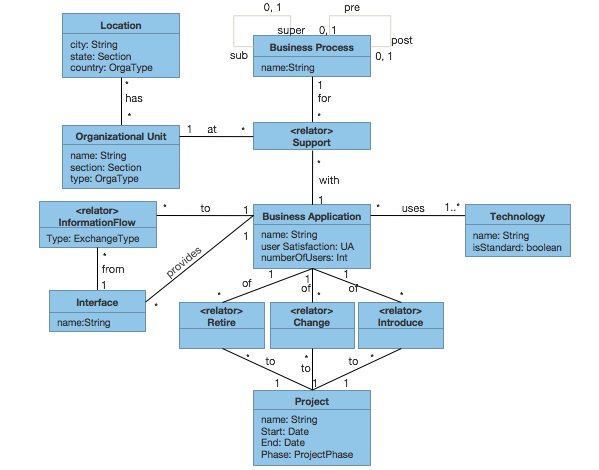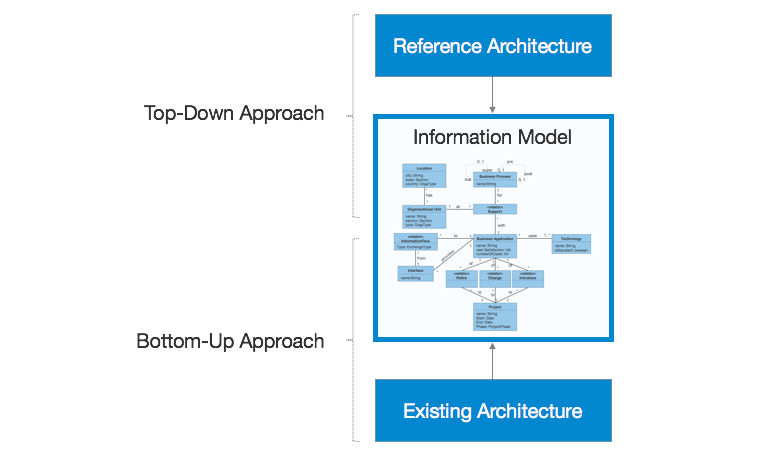An EA information model is a simplified representation of the elements of an enterprise architecture, their attributes and their relations to each other [RZM14]. A good information model can reduce the complexity of an enterprise architecture and supports informed decision making [11b].
EA Information Model Foundations
In the context of enterprise architecture, an information model provides a conceptual model of the enterprise architecture elements, their attributes and their relations to each other [RZM14; 11a; Buc+09c]. An overview of possible information model elements is provided by the TOGAF Architecture Content Framework [11b]. Figure 1 illustrates an example of an enterprise architecture information model which was created in accordance with the TOGAF Framework.

Figure 1: Example of an information model.
Even though many different information models have been introduced by literature and tool vendors [Bus+12], no overarching information model has been established in the field of EAM [BMS11a]. Therefore, some researchers claim that such models are enterprise-specific design artifacts [Buc+09d].
A good information model allows to structure elements of an enterprise architecture in a consistent way, which reduces the complexity of a system [11b]. Additionally, information about the system can be stored systematically, e.g. in a repository [Buc+09b], which enables advanced query and analysis opportunities [RZM14; 11b]. The results of such queries can be used as a basis for informed decision making [11b].
A main challenge when establishing an information model is to choose the best level of abstraction. On the one hand, if an information model collects too elaborate descriptions of the provided interfaces of the EA elements, it may lose its focus. Further, the data quality will decrease, because keeping all information up-to-date is connected with high efforts. On the other hand, the collected information needs to be detailed enough to provide a useful basis for decision making [Wit+07].
As indicated in Figure 2, there are two approaches to obtain an information model. On the one hand, an information model can be gained bottom-up [Mat11b]. This means, the information model of a system is gained by extracting it from existing information about a system [Mat11b]. One advantages of this approach is, that a system can grow freely and without having any structure forced on it right away [Mat11b]. Naturally emerging structures, processes and roles can be extracted and captured by the information model as soon as they surface [Mat11b]. Once captured, these commonalities of elements can be enforced to foster consistency of new EA elements [Mat11b]. Nevertheless, emerging information models are not always of high quality.

Figure 2: Approaches for creating an information model.
On the other hand, a top-down approach can be used [Mat11a]. This approach starts with the generation of an information model, which is created by a model designer. Once the model is constructed, the system is built up or adapted accordingly [Mat11a]. The advantage of this system is that proven reference architectures can be used for the design of the information model [11b]. Also, a higher quality of the overall architecture of the system is fostered at any time.
Sources:
|
[RZM14] |
S. Roth, M. Zec, and F. Matthes. Enterprise Architecture Visualization Tool Survey 2014. Tech. rep. Munich: Chair for Software Engineering of Business Information Systems. Technische Universität München., 2014. |
|
[Mat11b] |
F. Matthes. “Hybrid Wikis: Empowering Users to Collaboratively Structure Information.” In: 6th International Conference on Software and Data Technologies (ICSOFT). Seville, Spain, 2011, pp. 250–259. |
|
[Mat11a] |
C. Matthes Florian; Neubert. “Enabling Knowledge Workers to Collaboratively Add Structure to Enterprise Wikis.” In: 12th European Conference on Knowledge Management - ECKM 2011. University of Passau. 2011. |
|
[11b] |
TOGAF® Version 9.1, an Open Group Standard. Standard. The Open Group, 2011. |
|
[11a] |
ISO/IEC/IEEE 42010:2011 Systems and software engineering - Architecture description, Ingenierie des systemes et des logiciels - Description de l’architecture. Standard. International Organization for Standardization, 2011. |
|
[Buc+09c] |
S. Buckl, F. Matthes, C. Neubert, and C. M. Schweda. “A Wiki-based Approach to Enterprise Architecture Documentation and Analysis.” In: 17th European Conference on Information Systems (ECIS2009). Verona, Italy, 2009, pp. 1476–1487. |
|
[Bus+12] |
M. Buschle, S. Grunow, M. Hauder, F. Matthes, and S. Roth. “Automating Enterprise Architecture Documentation using Models of an Enterprise Service Bus.” In: Americas Conference on Information Systems (AMCIS 2012). Seattle, Washington, 2012. |
|
[Buc+09d] |
S. Buckl, F. Matthes, R. Ramacher, and C. Schweda. “Towards a Language for Enterprise Architecture Documentation and Analysis - Extending the Meta Object Facility.” In: The 4th International Workshop on Vocabularies, Ontologies and Rules for The Enterprise (VORTE 2009). Auckland, New Zealand, 2009. |
|
[Buc+09b] |
S. Buckl, A. M. Ernst, F. Matthes, and C. M. Schweda. “An Information Model for Managed Application Landscape Evolution.” In: Journal of Enterprise Architecture (JEA) (2009), pp. 12–26. |
| [Wit+07] |
A. Wittenburg, F. Matthes, F. Fischer, and T. Hallmermeier. “Building an integrated IT governance platform at the BMW Group.” In: Int. J. Business Process Integration and Management 2.4 (2007). |